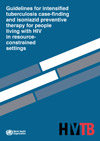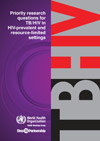No more people living with HIV, dying of TB
National HIV programmes are being called upon to step up efforts urgently to address HIV-related TB through the immediate and full implementation of the Three Is for HIV/TB and early initiation of ART. This is the essential package of interventions included in the WHO policy on collaborative TB/HIV activities and listed below that reduces the burden of TB among people living with HIV and that should be the responsibility of, and be provided by the HIV care and treatment provider, e.g. ART clinics, mother and child health clinics, harm reduction or needle exchange centres. Despite being preventable and curable, TB is still the leading killer of people living with HIV, with about a quarter of all HIV deaths found to be TB-related. A third of the 34 million people living with HIV worldwide is latently infected with Mycobacterium tuberculosis. People living with HIV, co-infected with latent TB are 21-34 times more likely to develop active TB disease than those without HIV. It is therefore essential that the transmission of TB infection is reduced through strong infection control measures and through timely diagnosis and treatment, and that latent infection is prevented from progressing to active disease.
The Three I’s for HIV/TB and early initiation of ART
-
Intensified TB case-finding and ensure high-quality anti-tuberculosis treatment
At every encounter with a health care worker, people living with HIV should be screened for TB using the WHO recommended four symptom screening algorithm. Those who do not report a current cough, fever, weight loss or night sweats are unlikely to have active TB and should be offered isoniazid preventive therapy (IPT). Those with any one of the four symptoms should be evaluated further for TB and other diseases, and treated accordingly. -
Isoniazid preventive therapy
IPT prevents latent TB infection from progressing to active disease. People living with HIV in whom active TB has been ruled out, should receive IPT for at least six months as part of a comprehensive package of HIV care, regardless of CD4 count, use of ART, history of previous TB treatment or pregnancy. -
Infection control
Integral to TB prevention among people living with HIV is sound policy and practice in TB infection control. Administrative, environmental and protective measures against the transmission of TB infection should therefore be implemented at all health care facilities, attended by people living with HIV as well as in other congregate settings such as prisons, harm reduction or opioid substitution therapy facilities. -
Early initiation of Antiretroviral Therapy
ART plays an extremely important role in both the prevention of TB and reducing the mortality of TB patients living with HIV. For this reason, WHO recommends the initiation of ART for people living with HIV with a CD4 count of <= 350 cells/mm3 and for those with WHO clinical stage 3 or 4 where CD4 testing is not available. ART should be provided as soon as possible to HIV positive TB patients and no later than eight weeks after TB treatment begins. ART should be given as a matter of emergency within the first two weeks of TB treatment among HIV-positive TB patients with profound immune-suppression (i.e.CD4 count < 50 cells/mm3).
Progress in the implementation and scale-up of the Three I’s for HIV/TB and early initiation of ART, whilst encouraging has been slow and intensified efforts are essential if we are to prevent this senseless disease burden and mortality, and in order to reach the targets set out in The Global Plan to Stop TB 2011-2015 and the Global Health Sector Strategy on HIV/AIDS 2011-2015. WHO’s Guidelines on Intensified tuberculosis case-finding and isoniazid preventive therapy for people living with HIV in resource-constrained settings backed up by key research findings, provide strong evidence to dispel a number of the barriers preventing the uptake of both intensive case finding and IPT. To read the WHO policy on TB infection control in health-care facilities, congregate settings and households please click on the following link and for its companion document to implement the policy click here.




 Intensive case finding and isoniazid preventive therapy guidelines, 2010
Intensive case finding and isoniazid preventive therapy guidelines, 2010
 Priority research questions for TB/HIV in HIV-prevalent and resource-limited settings, 2010
Priority research questions for TB/HIV in HIV-prevalent and resource-limited settings, 2010